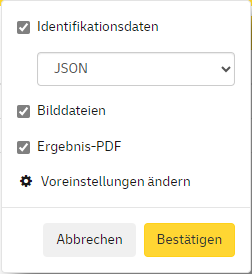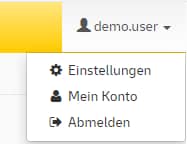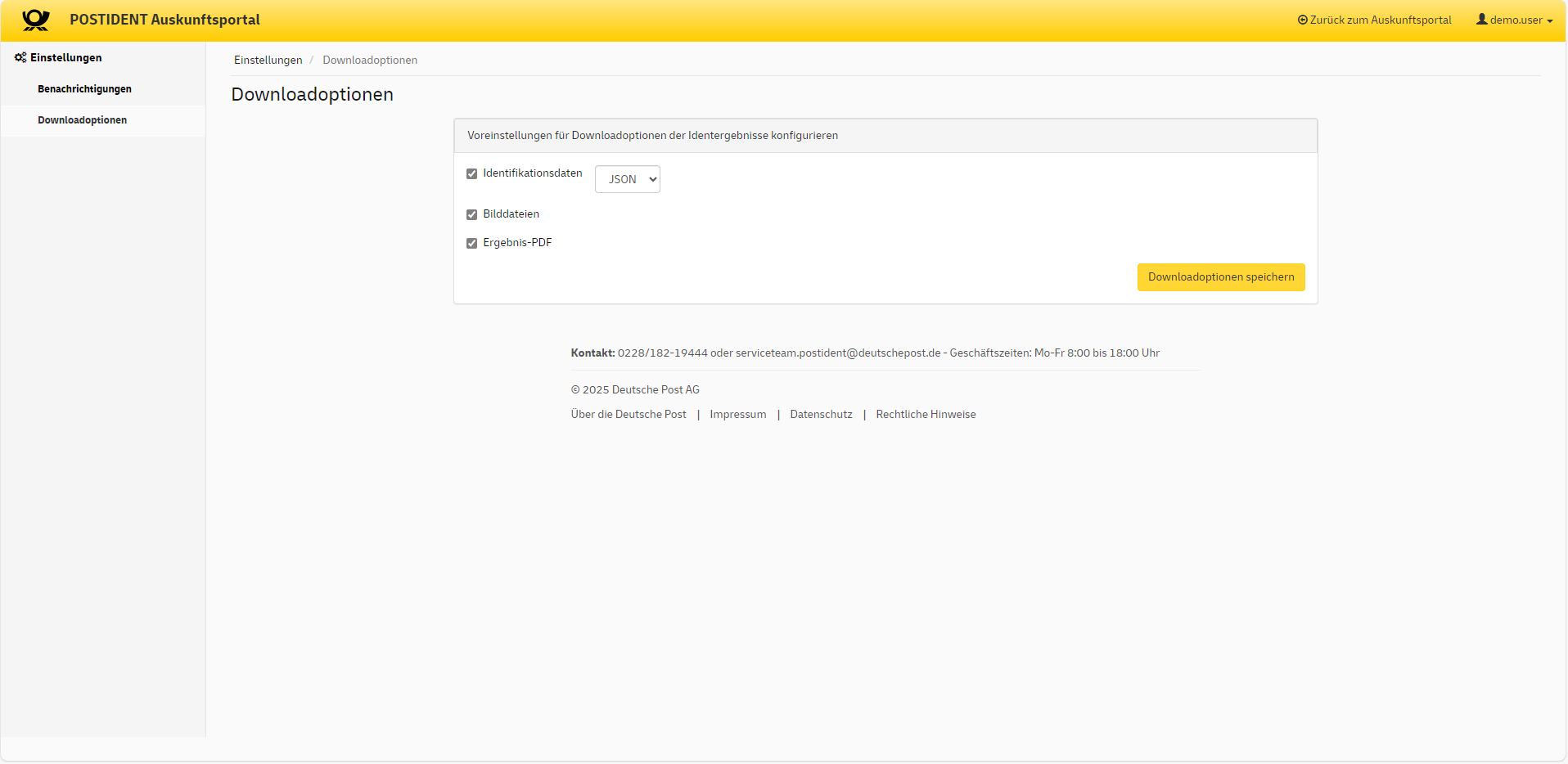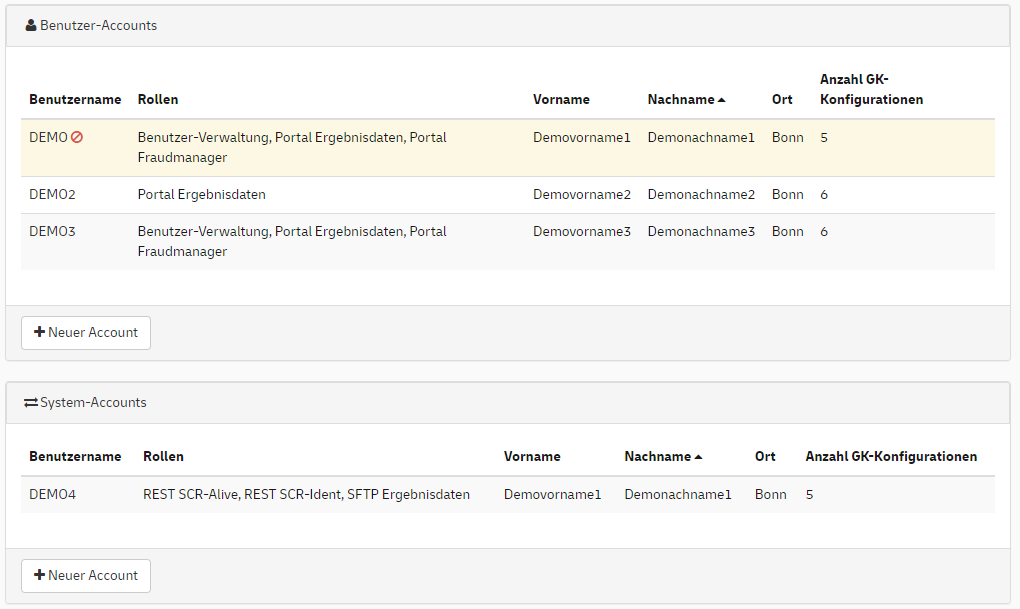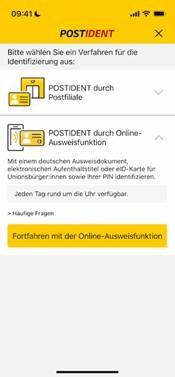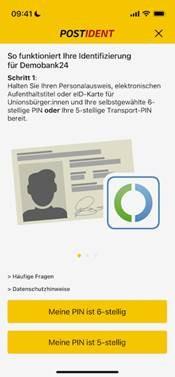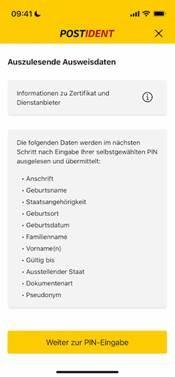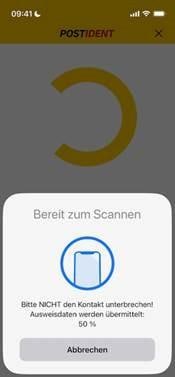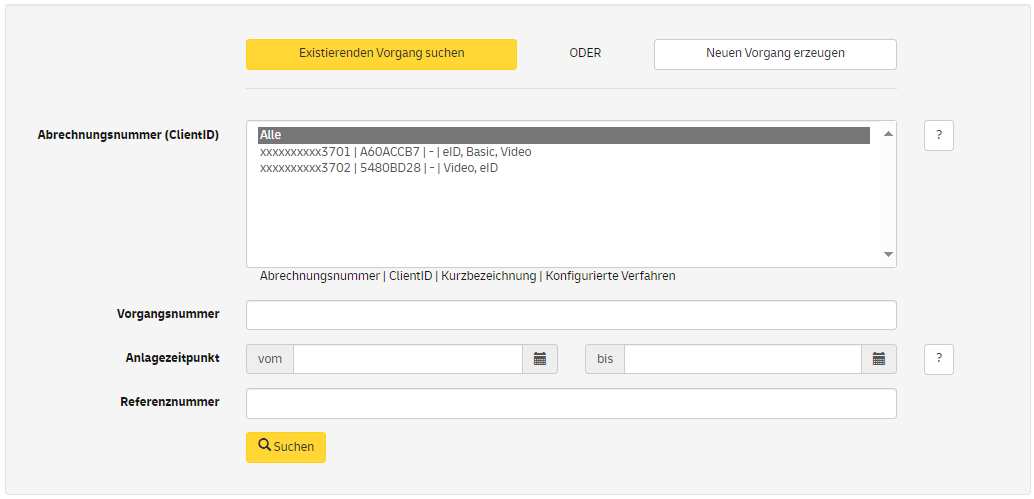| iOS |
2.1 |
27.07.2023 |
27.01.2024 |
- Support of the eID card for citizens of the EU and the EEA with POSTIDENT by online ID function (eID)
- UX improvements
- Videochat:
- Optimization of connection quality
- Improvement of image and video recordings
- Improvement of performance and stability
|
| iOS |
2.2 |
09.10.2023 |
09.04.2024 |
- Support of the user languages Spanish and Polish
- If the user has set up the languages Spanish or Polish in the smartphone/tablet settings, the POSTIDENT app will adopt the selected language. If the user has not set up German, Spanish or Polish, the default language is English.
- The support of the new languages Spanish and Polish only refers to the ident process in the app. E-mails and SMS will continue to be offered in German and English.
- Improvement of user understanding
- To explain the CAN (access number), the existing FAQ for the article "What is the CAN and what do I need it for?" will be added with Release 16.0. Specifically, the FAQ contains extended information on when to use the 6-digit access number on the front of the ID card.
- UX adjustments when using an iPad (iOS)
- Improved compatibility of older iPhones with a 720p front camera when using Fotoident
|
| iOS |
2.3 |
06.12.2023 |
06.06.2024 |
- POSTIDENT by online ID function
- Adjustment of individual text elements for POSTIDENT by online ID function process due to the rebranding of “AusweisApp2” to the new name “AusweisApp”
- POSTIDENT by video chat
- In order to make it easier for the user to interact with the agent, a new page is integrated before the chat starts. This page contains tips for the user so that the agent can quickly and easily recognize the security features on the ID card.
|
| iOS |
2.4 |
07.02.2024 |
07.08.2024 |
- POSTIDENT by AutoID
- Providing a SecondaryButton color definition for individual design customization
- POSTIDENT by video chat
- support of iPhone 15 Pro and 15 Pro Max camera lenses
- Discontinuation of iOS support for iOS 13 and 14
|
| iOS |
2.5 |
11.04.2024 |
11.10.2024 |
- SDK in general:
- Permission query for the "photo library" has been expanded
|
| iOS |
2.6 |
06.06.2024 |
06.12.2024 |
With SDK v2.5 we meet Apple's requirements regarding the Privacy Manifest.
- Online Identification Function (eID) with ID photo upload
- New feature "Online Identification Function (eID) with ID photo upload" for GwG customers to prompt the user to take a picture of the front and back of his ID card.
- Support for user languages French, Italian, Portuguese and Turkish
- Extension of language support for the apps (iOS/ Android) to include the languages French, Italian, Portuguese and Turkish
- Hologram Animation (AutoID)
- Display of an animation with a tilted ID document in the AutoID procedure (in step 2)
|
| iOS |
2.7 |
30.07.2024 |
30.01.2025 |
- Optimization of hologram animation (AutoID)
- Displaying an optimized animation with a tilted identification document in the AutoID process (in step 2)
- Correction of the Whitelabel color definition for the "queue" notification (before connecting with the VideoIdent agent)
- Optimization of user guidance for positioning the ID card on an iPhone in POSTIDENT using the online ID function (eID)
|
| iOS |
2.8 |
02.10.2024 |
02.04.2025 |
- Addition to the FAQs for forwarding to the ID card portal, so that the user can view a sample letter for the transport PIN
- Resolution of errors
|
| iOS |
2.9 |
exp. CW 48 2024 |
|
- Provision of the POSTIDENT SDK as a Compiled Version
- The "Place of Issue" field will no longer be displayed to users in the video chat process and thus will no longer be recorded (Video Chat)
- Improved support for the camera lenses of the iPhone 16, iPhone 16 Plus, iPhone 16 Pro, iPhone 16 Pro Max
- Support for SDK version 2.1 will be discontinued
|
| Android |
2.0 |
23.06.2023 |
23.12.2023 |
- Replacement of the previous video interface for POSTIDENT by video chat
- Replacement of the previous "IceLink" video interface with a WebRTC interface developed in-house
- Ensuring the future performance and stability of the iOS framework
- Further improvements of the video chat connectivity quality
- Correct selection of the camera on PRO models
- Support of the electronic residence permit with POSTIDENT by online ID function (eID) for GwG and eIDAS identifications
|
| Android |
2.1 |
27.07.2023 |
27.01.2024 |
- Support of the eID card for citizens of the EU and the EEA with POSTIDENT by online ID function (eID)
- UX improvements
- Videochat:
- Optimization of connection quality
- Improvement of image and video recordings
- Improvement of performance and stability
|
| Android |
2.2 |
09.10.2023 |
09.04.2024 |
- Support of the user languages Spanish and Polish
- If the user has set up the languages Spanish or Polish in the smartphone/tablet settings, the POSTIDENT app will adopt the selected language. If the user has not set up German, Spanish or Polish, the default language is English.
- The support of the new languages Spanish and Polish only refers to the ident process in the app. E-mails and SMS will continue to be offered in German and English.
- Improvement of user understanding
- To explain the CAN (access number), the existing FAQ for the article "What is the CAN and what do I need it for?" will be added with Release 16.0. Specifically, the FAQ contains extended information on when to use the 6-digit access number on the front of the ID card.
|
| Android |
2.3 |
07.12.2023 |
07.06.2024 |
- POSTIDENT by online ID function
- Adjustment of individual text elements for POSTIDENT by online ID function process due to the rebranding of “AusweisApp2” to the new name “AusweisApp”
- POSTIDENT by video chat
- In order to make it easier for the user to interact with the agent, a new page is integrated before the chat starts. This page contains tips for the user so that the agent can quickly and easily recognize the security features on the ID card.
|
| Android |
2.4 |
05.02.2024 |
05.08.2024 |
- POSTIDENT by AutoID
- Providing a SecondaryButton color definition for individual design customization
- POSTIDENT by video chat
- Discontinuation of Android support for Android 5, 6 and 7
|
| Android |
2.4.1 |
14.02.2024 |
14.08.2024 |
Correction of an error in the handling of CallBackUrls when using the AutoID method |
| Android |
2.5 |
11.04.2024 |
11.10.2024 |
- Video chat:
- Correction of faulty behavior when the SDK crashes during a video chat and the speaker can no longer be activated correctly
- SDK in general:
- Correction of faulty behavior when the user rejects a permission request (on first query)
- Updating of the developer SDK README documentation
|
| Android |
2.6 |
06.06.2024 |
06.12.2024 |
- Online Identification Function (eID) with ID photo upload
- New feature "Online Identification Function (eID) with ID photo upload" for GwG customers to prompt the user to take a picture of the front and back of his ID card.
- Support for user languages French, Italian, Portuguese and Turkish
- Extension of language support for the apps (iOS/ Android) to include the languages French, Italian, Portuguese and Turkish
- Hologram Animation (AutoID)
- Display of an animation with a tilted ID document in the AutoID procedure (in step 2)
|
| Android |
2.7 |
25.07.2024 |
25.01.2025 |
- Optimization of hologram animation (AutoID)
- Displaying an optimized animation with a tilted identification document in the AutoID process (in step 2)
|
| Android |
2.8 |
02.10.2024 |
02.04.2025 |
- Discontinuation of support for Android 8
- Addition to the FAQs for forwarding to the ID card portal, so that the user can view a sample letter for the transport PIN
- Resolution of errors
|
| Android |
2.8.1 |
16.10.2024 |
16.04.2025 |
- Bugfix for AutoID for the case where a user wants to restart the SDK after the AutoID procedure has already been completed once
|
| Android |
2.9 |
exp. cw 48 2024 |
|
- Provision of the POSTIDENT SDK as a Compiled Version
- The "Place of Issue" field will no longer be displayed to users in the video chat process and thus will no longer be recorded (Video Chat)
- Support for SDK version 2.1 will be discontinued
|


